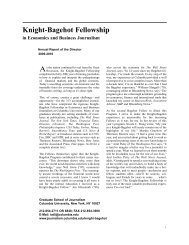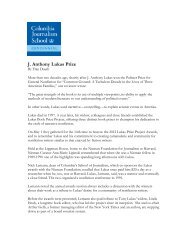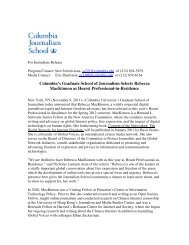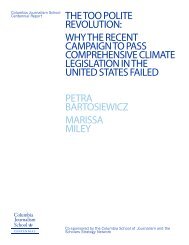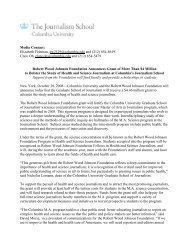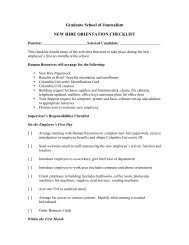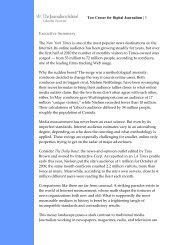Claude Steele talk - Columbia University Graduate School of ...
Claude Steele talk - Columbia University Graduate School of ...
Claude Steele talk - Columbia University Graduate School of ...
You also want an ePaper? Increase the reach of your titles
YUMPU automatically turns print PDFs into web optimized ePapers that Google loves.
Performance<br />
Criterion <br />
(e.g., Freshman<br />
or Cumulative<br />
GPA) <br />
All Students<br />
Ability <br />
Stereotyped <br />
Students (e.g.,<br />
Women in<br />
math, <br />
African<br />
Americans)<br />
Ability (Preparation) Predictor Scores (e.g., SAT scores) <br />
Underperformance: At every level <strong>of</strong> preparation, performance on the criterion measure is lower<br />
for members <strong>of</strong> the ability-stereotyped group.
30<br />
25<br />
20<br />
15<br />
10<br />
Women<br />
Men<br />
5<br />
0<br />
Gender<br />
Difference<br />
No Gender<br />
Difference
Stereotype Threat & Performance on Raven’s Progressive<br />
Matrices by Among Afrißcan American Students<br />
Brown & Day Journal <strong>of</strong> Applied Psychology, 2004<br />
25<br />
24<br />
23<br />
22<br />
21<br />
Black Students<br />
White Students<br />
20<br />
19<br />
Puzzle Standard IQ
The Nature <strong>of</strong> Social Identity Threat<br />
(like a snake loose in the house)<br />
• You know that, based on an identity you<br />
have, something bad could happen.<br />
• You don’t know whether, in fact, it will<br />
happen.<br />
• You don’t know precisely what could<br />
happen.<br />
• You don’t know when it could happen.<br />
• You don’t know where it could happen.
•Cues that signal non-threatening<br />
contingences foster belonging<br />
in the setting and thus, learning<br />
and performance.
Cues that signal threatening<br />
contingencies foster vigilance<br />
and hamper a sense <strong>of</strong><br />
belonging in the setting. This, in<br />
turn, impairs learning and<br />
performance.
Contingencies deriving from features<br />
<strong>of</strong> a setting that would exist even<br />
without ongoing prejudice<br />
• Identity-based marginalization<br />
• Identity-segregated networks, personal &<br />
pr<strong>of</strong>essional<br />
• Stereotype threat<br />
• The form <strong>of</strong> “color-blindness” in which group<br />
differences in identity contingencies are not<br />
recognized<br />
• Low priority on identity integration in the setting<br />
• The identity threat <strong>of</strong> others
Neutral<br />
Structural Cue<br />
Office
Threatening<br />
Structural Cue<br />
Office
Summer Conference Video<br />
•Balanced Video (1:1) Murphy •Unbalanced & <strong>Steele</strong> Video (3:1)<br />
•2 (participants gender) X 2 (video) factorial design<br />
Unbalanced Video = cue <strong>of</strong> identity threat for women
Vigilance: Recognition Memory for<br />
Details <strong>of</strong> the Conference Video<br />
Number correct: 15 total items<br />
15<br />
14.5<br />
14<br />
13.5<br />
13<br />
12.5<br />
12<br />
Unbalanced Video<br />
Balanced Video<br />
Men<br />
Women<br />
Interaction, F(3, 42) = 4.35, p < .01
Vigilance:<br />
Recall <strong>of</strong> Cues in Experimental Room<br />
6.5<br />
Number <strong>of</strong> items<br />
recalled ( 7 possible)<br />
6<br />
5.5<br />
5<br />
4.5<br />
4<br />
3.5<br />
3<br />
Unbalanced Video<br />
Balanced Video<br />
Men<br />
Women<br />
Interaction, F(3, 46) = 2.80, p < .05
Cardiovascular Reactivity<br />
Z-scores Composite*<br />
4<br />
3<br />
2<br />
1<br />
0<br />
-1<br />
-2<br />
-3<br />
-4<br />
-5<br />
-6<br />
-7<br />
Unbalanced Video<br />
Balanced Video<br />
Men<br />
Women<br />
Interaction: F(3, 42) = 4.35, p < .01<br />
* Finger pulse amplitude, Ear pulse amplitude, Finger pulse transit time, Temperature
Sense <strong>of</strong> Belonging<br />
13.5<br />
0-15 scale<br />
13<br />
12.5<br />
12<br />
11.5<br />
Men<br />
Women<br />
11<br />
Unbalanced Video<br />
Balanced Video<br />
Interaction: F(3, 46) = 2.17, p < .04
•Bad news: Identity threat is<br />
intrinsic to most diverse/<br />
integrated settings, breeching<br />
the trust needed to function<br />
comfortably & optimally in the<br />
setting.
•Good news: Some level and<br />
salience <strong>of</strong> identity safety/trust<br />
cues in a setting can foster trust<br />
even when other cues in the<br />
setting might suggest otherwise.
Identity Safety or Trust<br />
•Without identity trust, no<br />
instructional or managerial<br />
strategy is likely to be effective.<br />
•With this trust, a broad variety<br />
<strong>of</strong> such strategies can be<br />
effective.
Achieving the inter-subjective sense <strong>of</strong> “identity<br />
safety”: Strategies for Settings<br />
• Leadership/Normative Influence<br />
• Critical Mass<br />
• Resist permanent tracking & fixed ability representations<br />
<strong>of</strong> jobs, careers, tests & performances<br />
• De-racializing perception <strong>of</strong> setting<br />
• Self-Affirmation<br />
• Belongingness Interventions<br />
• Challenge & support (e.g., feedback)<br />
• Relationships<br />
• “Wise” teaching; all <strong>of</strong> the above
<strong>School</strong>ing Policy<br />
(Positioning these processes in school reform)<br />
Quality <strong>School</strong>ing: Necessary but not sufficient to<br />
reduce group performance gaps.<br />
Identity Safety: Necessary but not sufficient to reduce<br />
group performance gaps.<br />
Quality <strong>School</strong>ing plus Identity Safety both necessary<br />
and sufficient to reduce group performance gaps.
The Underperformance Phenomenon<br />
Performance<br />
Criterion <br />
(e.g., Freshman<br />
or Cumulative<br />
GPA) <br />
All Students<br />
Ability <br />
Stereotyped <br />
Students (e.g.,<br />
Women in<br />
math, <br />
African<br />
Americans)<br />
Ability (Preparation) Predictor Scores (e.g., SAT scores) <br />
Underperformance: At every level <strong>of</strong> preparation, performance on the criterion measure is lower<br />
for members <strong>of</strong> the ability-stereotyped group.
Black Student Over-Performance<br />
Walton & Spencer In Press
•The most psychologically<br />
impactful identity contingencies<br />
are those that in some way<br />
threaten the individual.
Social Identity: The part <strong>of</strong> personal identity<br />
--our sense <strong>of</strong> who we are-- that comes from <br />
our group memberships and the social categories<br />
to which we belong: our age, sex, race, <br />
religion, pr<strong>of</strong>ession, ethnicity, nationality, sexual <br />
orientation, region, social class, ideological <br />
persuasion, political affiliation, mental health <br />
status, etc.
Contingencies <strong>of</strong> Social Identity: The particular<br />
way that society and settings are set to judge and<br />
treat people based on a social identity they <br />
have.
By affecting the comfort level and performance<br />
pressure that we feel in specific situations and <br />
in entire walks <strong>of</strong> life, identity contingencies<br />
can affect both specific performances and <br />
life defining choices <strong>of</strong> careers, relationships, <br />
regions <strong>of</strong> the country to live in, etc.
“People <strong>of</strong>ten see themselves in terms <strong>of</strong> <br />
whichever one <strong>of</strong> their allegiances (identities) <br />
is under attack…whether he accepts or <br />
conceals it, proclaims it discreetly or flaunts it, <br />
it is with that allegiance that the person <br />
concerned identifies” (p. 26) Amin Maalouf <br />
from In the Name <strong>of</strong> Identity; Violence and the<br />
Need to Belong.
•Social identities originate from,<br />
and are sustained by<br />
contingencies that go with them<br />
in particular situations.
Social Distance as a Function <strong>of</strong> Race <strong>of</strong> Conversation<br />
Partner & Topic<br />
G<strong>of</strong>f, <strong>Steele</strong> & Davies, Journal <strong>of</strong> Personality and Social Psychology, In Press<br />
40<br />
39.5<br />
39<br />
38.5<br />
38<br />
37.5<br />
37<br />
36.5<br />
36<br />
35.5<br />
35<br />
Black<br />
Partn<br />
White<br />
Partn<br />
Racial Pr<strong>of</strong>iling<br />
Relationships
Activation <strong>of</strong> Brain Areas Used for Math Performance by<br />
Women Doing Math<br />
(Angular Gyrus & Left Parietal & Prefrontal Cortex) Krendl, Richeson, Kelley<br />
& Heatherton Psychological Science<br />
0.9 1 Control Threat<br />
0.8<br />
0.7<br />
0.6<br />
0.5<br />
0.4<br />
0.3<br />
0.2<br />
0.1<br />
-0.1 0<br />
-0.2<br />
-0.3<br />
-0.4<br />
-0.5<br />
-0.6<br />
-0.7<br />
-0.8<br />
-0.9<br />
-1<br />
Time 1<br />
Time 2
Activation <strong>of</strong> Brain Areas Associated with Social/Emotional<br />
Processing among Women Doing Math<br />
(ventral anterior cingulate cortex)<br />
Krendl, Richeson, Kelley & Heatherton Psychological Science<br />
0.9 1 Control Threat<br />
0.8<br />
0.7<br />
0.6<br />
0.5<br />
0.4<br />
0.3<br />
0.2<br />
0.1<br />
-0.1 0<br />
-0.2<br />
-0.3<br />
-0.4<br />
-0.5<br />
-0.6<br />
-0.7<br />
-0.8<br />
-0.9<br />
-1<br />
Time 1<br />
Time 2
Toward Remedy
Trust and comfort composite for Black participants
18<br />
16<br />
14<br />
12<br />
10<br />
8<br />
6<br />
4<br />
2<br />
0<br />
No Sex Diff<br />
Ster Thr<br />
Genetics<br />
Experimental
-0.1<br />
-0.2<br />
-0.3<br />
-0.4<br />
Post Intervention Achievement Composite<br />
(Review session, study group & <strong>of</strong>fice hour attendance, hours spent studying,<br />
emails to pr<strong>of</strong>essors, in standardized score units)<br />
Walton & Cohen, Journal <strong>of</strong> Personality and Social Psychology, 2007<br />
0.4<br />
0.3<br />
0.2<br />
0.1<br />
0<br />
White<br />
Students<br />
Black<br />
Students<br />
Control<br />
Treatment
GPA Change Pre and Post Intervention<br />
(In Unstandardized residuals)<br />
Walton & Cohen, Journal <strong>of</strong> Personality and Social Psychology, 2007<br />
0.4<br />
0.3<br />
0.2<br />
0.1<br />
0<br />
-0.1<br />
-0.2<br />
-0.3<br />
-0.4<br />
White<br />
Students<br />
Black<br />
Students<br />
Campus Wide<br />
Control<br />
Treatment
First Term GPA <strong>of</strong> <strong>University</strong> <strong>of</strong> Michigan Students (1994) by Program &<br />
Admission Status<br />
4<br />
3.8<br />
3.6<br />
3.4<br />
3.2<br />
3<br />
2.8<br />
2.6<br />
2.4<br />
2.2<br />
2<br />
21st<br />
Century<br />
Random<br />
Cntrl<br />
(n=6)<br />
General<br />
Pop<br />
Black Students<br />
Whites Students
Achieving the inter-subjective sense <strong>of</strong><br />
“identity safety”:<br />
Individual Strategies<br />
•Learning goals and self-management.<br />
•Attributional strategies<br />
•Stereotype dilution<br />
•Thorough skill building--a role for<br />
supplemental education
Distance Results<br />
60<br />
Inches<br />
55<br />
50<br />
45<br />
40<br />
Racial<br />
Pr<strong>of</strong>iling<br />
Love &<br />
Relationship<br />
s<br />
35<br />
Evaluative Goals<br />
Learning Goals<br />
F (1, 51) = 9.46<br />
p < .01
Task Motivation by Race and Feedback Condition<br />
(Composite motivation index in standardized scores. Sample item”:How motivated are you to<br />
revise your essay before submitting to the journal?”)<br />
(Cohen, <strong>Steele</strong> & Ross, 1999)<br />
0.5<br />
0.4<br />
0.3<br />
0.2<br />
0.1<br />
0<br />
-0.1<br />
-0.2<br />
-0.3<br />
-0.4<br />
-0.5<br />
Unbuffered<br />
Hi<br />
Standards<br />
Hi Stand.<br />
+Assurance<br />
Black Participants<br />
White Participants
Change in Mean Arterial Pressure (MAP) from Pre-Test Resting Baseline<br />
(Millimeters <strong>of</strong> Mercury)<br />
4<br />
3<br />
2<br />
1<br />
0<br />
-1<br />
White Participants<br />
Black Participants<br />
-2<br />
"No Race<br />
Difference"<br />
Race<br />
Difference<br />
Presumed
-0.75<br />
-0.50<br />
Test Performance<br />
(Standard Deviation<br />
-0.25<br />
0.00<br />
0.25<br />
0.50<br />
0.75<br />
1.00
Identity Trust or Safety<br />
When cues or experiences in a<br />
setting support an understanding<br />
that identity-based contingencies<br />
won’t foreclose important<br />
opportunities, a sense <strong>of</strong> identity<br />
trust can result even when other<br />
cues or experiences suggests<br />
otherwise.



